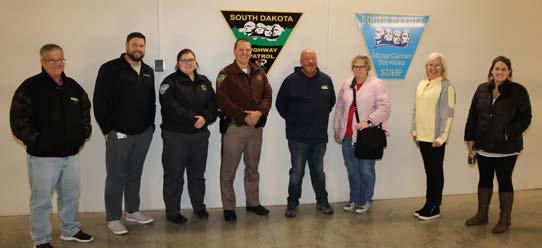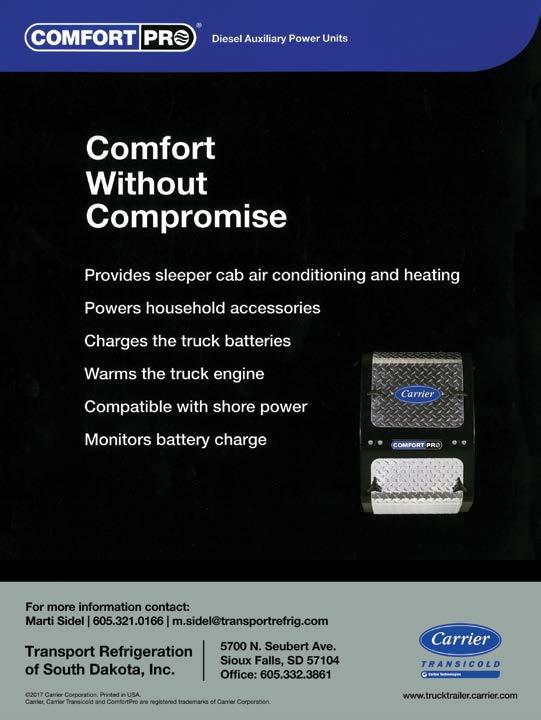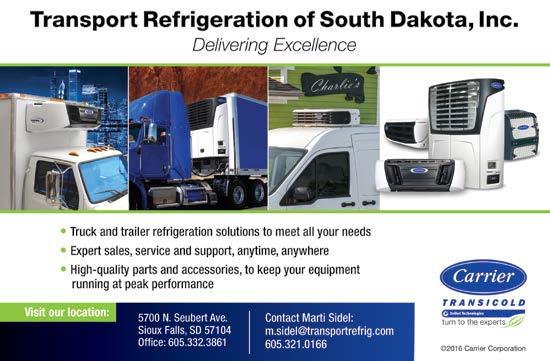
13 minute read
FMCSA Proposes Expanding Classifications for Under-21 Pilot Program
October 9, 2020 • by HDT Staff The Federal Motor Carrier Safety Administration’s pilot program to allow 18-to-20-year-olds service members with heavy-vehicle driver training to operate commercial motor vehicles might expand the Military Occupational Specialties (MOS) classifications to open the program to a wider pool of candidates.
As part of the Fixing America's Surface Transportation (FAST) Act, the pilot program was implemented to increase the number of truck drivers by providing service members the opportunity to transition to commercial driving jobs, as long as they are not transporting passengers or hazardous cargo, or operating a vehicle in a “special configuration.”
Advertisement
The seven original MOS classifications approved for the pilot program in July 2018 included: • 88M Motor Transport Operator (Army) • 92F Fueler (Army) • 3531 Motor Vehicle Operator (Marines) • E.O. Equipment Operator (Navy) • 2TI Vehicle Operator (Air Force) • 2FO Fueler (Air Force) • 3E2 Pavement and Construction Equipment Operator (Air Force)
FMCSA is proposing to expand the list of eligible classifications to include: • 12B Combat Engineer (Army) • 13B Field Artillery (Army) • 13P Multiple Launch Rocket System (Army) • 88H Transportation Cargo (Army) • 14T Patriot Launching Station Operator (Army) • 3537 After 3531 achieves the rank of SSgt (Marine Corps) • 0811 Field Artillery Cannoneer (Marine Corps) • 1371 Combat Engineer (Marine Corps) • 1345 Engineer Equipment Operator (Marine Corps) FMCSA is now requesting comments on the possibility of including the additional MOS classifications, which are due on or before November 9, 2020. (https://www.federalregister.gov/documents/2020/10/09/2020-22401/commercial-drivers-licenses-expansion-of-military-occupational-specialties-in-the-pilot-program-to)


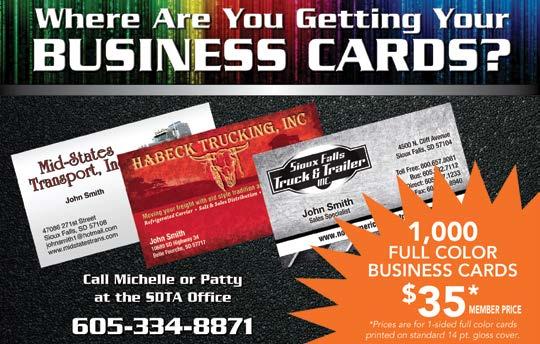

FMCSA’S DECK OUTLINES AGENCY’S ONGOING INITIATIVES FMCSA Deputy Administrator Wiley Deck outlined the regulatory body's plans for hours of service relief, under 21 pilot programs, and new safety technology in trucking.
by Cristina Commendatore

OCT 26, 2020 -- One of the most notable achievements of the Federal Motor Carrier Safety Administration (FMCSA) this year has been the implementation of the new hours of service (HOS) rules and regulatory relief during the pandemic. For the remainder of the year and heading into 2021, the agency has its eyes on the driver shortage and two pilot programs for drivers under the age of 21, additional HOS relief for commercial drivers, and working with industry stakeholders to encourage the adoption of new safety technologies in trucking. “This year, obviously, the attention and the focus has been on the COVID-19 pandemic response,” said FMCSA’s Deputy Administrator Wiley Deck during the American Trucking Associations (ATA) virtual Management Conference and Exhibition (MCE) on Oct. 23. Over the course of the pandemic, the U.S. Department of Transportation (DOT) and FMCSA took on new actions in terms of regulatory waivers and exemptions for truckers working on the front lines. “The first-ever national emergency declaration was declared this year in response to the pandemic to ensure that the supply chain kept moving; to ensure that food got where it needed to get to; that livestock, feed, and agricultural products got to where they needed to get to; that medical supplies in response to the pandemic were able to be moved around; and that we were able to restock our grocery stores,” explained Deck. “During this time, we have seen what truck drivers really do. We will be able to collect some unique data on what’s going on today based on relief from the hours of service regulations and see how that plays into a wide variety of different points.” Deck outlined the agency’s efforts since the start of the pandemic in the U.S. in March and then went on to relay several of the agency’s initiatives moving forward.
Regulatory Relief
This year, FMCSA was required to increase random testing efforts for drug and alcohol use among commercial truck drivers. Due to the pandemic, trucking companies and other industry stakeholders informed FMCSA that they couldn’t get their drivers in for tests because either medical offices were closed, or their drivers were concerned about COVID exposure. FMCSA provided relief through the end of the year to ensure that testing could still go on for those who could meet the requirements, and issued a waiver for those who could not. The agency took efforts to ensure that those with expiring commercial driver’s licenses (CDLs) could continue to operate and help the flow of goods and medical supplies around the country. FMCSA temporarily waived medical requirements and certificates for commercial motor vehicle (CMV) drivers. FMCSA also provided relief through Dec. 31 on the third-party CDL skills testing as regulators noticed that state DMVs needed relief. Deck explained that moving forward, the agency will look at all these waivers and exemptions to determine whether they should be continued or not. Decisions will be made based on data and input from communications with the agency’s stakeholders, he said.
HOS, Addressing the Driver Shortage
After FMCSA received 8,000 comments from a wide variety of CMV drivers, safety advocates, and the trucking industry, the new HOS rules finally went into effect on Sept. 29. Based on the data and public comments, FMCSA changed four main areas to the Continued on page 19
WWW.NORPASS.ORG

The NORPASS partners are committed to promoting safe and efficient trucking though out North America. Through the combination of mainline screening devices and compatible transponders, participating safe and legal commercial vehicles are allowed to bypass specific weigh stations allowing enforcement to concentrate its efforts on high-risk carriers.





Participation in NORPASS is voluntary. The only cost to the carrier is the charge for the transponder. There are no monthly or annual fees.
T To avoid stopping at weigh stations call 1-888-877-8567.
Phone 888.877.8567 | Fax 360.705.6836 | transponderadmin@wsdot.wa.gov

INITIATIVES continued...
federal HOS rules: short-haul exception, adverse driving conditions, 30-minute rest break requirement, and sleeper berth provision. “None of the changes we implemented increased the driving time for these drivers,” Deck explained. “It just provided that flexibility that the drivers needed to make sure they were able to manage their own fatigue and not feeling the need to race the clock.” As part of the HOS rulemaking, there were several provisions that were proposed but didn’t carry over to the final rule. One of those was part of a split-duty period, which would allow for an up to three-hour pause of a driver’s clock. The agency ended up moving forward with a Split Duty Period Pilot Program, with public comments due by Nov. 2. FMCSA is also looking to address the CMV driver shortage with two pilot programs—an under 21 military CDL program and an under 21 program for nonmilitary drivers. The under 21 military CDL pilot program kicked off last June, but Deck said FMCSA had difficulty recruiting drivers. “We engaged the National Guard, the Reserves, and we had gone out to speak to large classes of drivers being trained, but we just haven’t made any headway on this,” Deck explained. “While the study is supposed to run for three years, it will have to be extended because we are not getting the drivers we need to in a good sampling.” “We are trying to collect that data of under 21 drivers to address the driver shortage,” Deck added. “The average age of a driver transitioning into the industry now is 36. The average of a driver in the industry is currently 56 or 57. We have an aging population of drivers. We need to find a way to encourage the younger driver to enter the industry. By doing that, we can make sure we have enough drivers to do what needs to be done and make sure our supply chain is flowing and our economy continues to grow.” On Sept. 10, FMCSA published a proposal for a second program for under 21 drivers geared toward non-military drivers. The DRIVE-Safe Act was used as the basis for this pilot program. Comments are due by Nov. 9, and younger drivers can participate in one of the two categories: Category one is 120 hours on duty and part of an apprenticeship program modeled after the DRIVE-Safe Act. Participating drivers must have 80 hours of drive time, while also completing specific requirements. Category two is 280 hours of on-duty time with 160 hours of driving, as well as completing specific requirements. This too would allow drivers with one year of experience and 25,000 miles to participate in this pilot program and haul freight across state lines.
Driver Issues, CDL Rulings, Drug Testing
According to Deck, entry-level driving training is a key rulemaking for FMCSA to ensure the safe operations of CMVs; however, FMCSA has extended the rulemaking deadline until Feb. 7, 2022, due to information technology (IT) issues. The rule was originally supposed to take effect in February 2020. Deck explained that the agency has been working with the states to ensure that they could accept driver training certificates on the training provider registry from CDL schools; ensure there is a secure environment for those certificates; and ensure that the individual applying for their CDL actually received the proper training. “We are working with our state driver’s license agencies to make sure they have the correct IT to ensure we are able to move forward with this to make that February 2022 full implementation date,” Deck advised. Deck also noted that over the course of the pandemic, FMCSA learned that having flexibility around obtaining a CDL is key for trucking. That flexibility includes allowing third-party testers to train CDL students, he said. “We have seen instances now where some states are closed and they have not given knowledge tests, or they are backlogged right now,” Deck pointed out. “So, that delay is significant in getting those knowledge tests done so a driver can start the process of obtaining their license.” When it comes to testing drivers for drug and alcohol usage, in January, FMCSA opened its Drug & Alcohol Clearinghouse. There are 1.5 million registered users right now, as well as more than 2 million queries in the clearinghouse. “Both fortunate and unfortunate, we are seeing a large number of folks that we captured within this clearinghouse,” Deck said. “Right now, there are 42,000 reported violations. Some of those individuals captured in this clearinghouse data probably would Continued on page 21 TRUCKING NEWS ~ PAGE 19
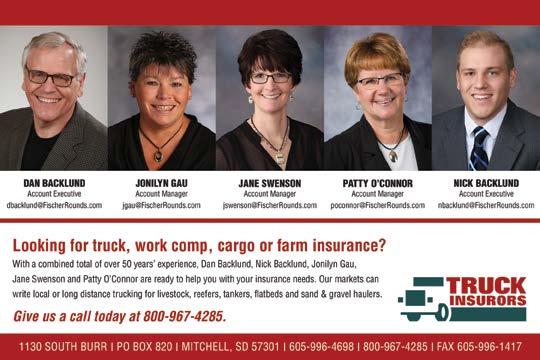
DOT SERVICES • DOT Physicals • DOT and Non-DOT Drug Screening and Alcohol Testing • MRO Services • Injury Care (billed at South Dakota Work Comp Fee Schedule) • Third Party Administration • Employee Assistance Plan • Additional Occupational Health Services • Efficient, Friendly, Professional Services


Avera EPA Services is Now Offering...
DOT-QUALIFIED
SUBSTANCE ABUSE PROFESSIONALS The Avera Employee Assistance Program (EAP) offers substance abuse evaluations for employees who test positive for drugs or alcohol, as regulated by the Department of Transportation (DOT). Under DOT regulations, safety-sensitive employees (i.e., truck drivers, pilots and airline workers, transit workers, pipeline workers, etc.) are subject to pre-employment, random, post-accident, and reasonable suspicion drug and alcohol tests. When there is a positive test result, the DOT-regulated employee must seek the service of a DOT-qualified Substance Abuse Professional (SAP). 605-322-4069 Call 605-322-5100 to schedule an appointment.
2100 South Marion Road Sioux Falls, SD 57106
not have been caught before. They would have found some way to skirt the system and pop up somewhere else and be on our roads. None of us want that.” The top drugs reported in the clearinghouse are marijuana, cocaine, and amphetamines and methamphetamines. FMCSA is also accepting comments on the joint Department of Health and Human Services (HHS) rule on hair testing. Comments close on Nov. 9. Once complete, Deck said the next step is for HHS and FMCSA to engage in the rulemaking as it relates to individual organizations. In September, FMCSA announced it would add a subcommittee to its Motor Carrier Safety Advisory Committee (MCSAC). The MCSAC includes a representation of fleets, owner-operators, law enforcement, and safety advocates, but not active CDL holders. The subcommittee will comprise active 25 CDL holders running the gamut of the CMV industry, Deck said. The goal is for drivers to provide a wide variety of viewpoints on what does and doesn’t work for them. “The purpose of this panel is to review and look at our regulations, look at safety issues, look at training, truck parking, driver experience, and how we at FMCSA can do our jobs better to ensure our roads are safe,” Deck said, adding the agency is currently reviewing hundreds of applications.
CSA Scores, Technology Initiatives
Under the FAST Act, FMCSA is required to review the Compliance, Safety, Accountability (CSA) scoring system and to engage the National Academy of Sciences to look at some statistical challenges within that system. The academy recommended the Item Response Theory (IRT) in 2017 as an alternative to the CSA Safety Measurement System scoring method. “We are making headway,” Deck said. “We are in the final review right now of IRT and how it can help improve our system of monitoring high-risk carriers.” “It’s a challenging system, and a challenging part for the agency is to explain how we derive our numbers,” Deck added. “Under the current system, you can easily calculate what your CSA score is. IRT makes that a lot more challenging. We hope to make an announcement in the near future on the path forward that we are going to take.” Related to CSA, FMCSA’s Crash Preventability Determination Program allows carriers to submit crashes in 16 crash types. FMCSA found that 97% of those crashes are nonpreventable. For instance, according to Deck, a crash would be nonpreventable if a part of a bridge falls on a truck and causes a crash, or a wild animal jumps in front of a truck while it’s driving. “The intent of this is to remove those crashes from the CSA scores because by including those types of crashes that are nonpreventable doesn’t give us good data, and it doesn’t allow us to process this data in a meaningful manner that gives us good results,” Deck said. “The program is something we tend to continue, and, in the future, it may even grow beyond these 16 crash types. We’ll be analyzing that as we move forward.” When it comes to technology initiatives, TECH-Celerate Now is a partnership among FMCSA, ATA’s Technology & Maintenance Council, the American Transportation Research Institute (ATRI), and the Owner-Operator Independent Drivers Association (OOIDA). It was developed to encourage the adoption of advanced driver assistance systems (ADAS), like automatic emergency braking, lane departure assistance, and forward collision avoidance, in trucking. “We are trying to encourage the voluntary adoption of these new technologies in the industry,” Deck said. “We have heard from some who have started to install these systems that they have seen a 60% reduction in the number of rear-end collisions. Out of the remaining 40%, they have seen a 90% reduction in the severity of the collisions. That’s a tremendous savings of life and property.” The agency is also looking at automated driving systems (ADS). “The intent is not to direct what type of technology that industry should use; we want to be technology-neutral,” Deck explained. “It’s coming. It’s happening,” Deck added. “We want to ensure that those vehicles are operating in a safe manner and that our law enforcement partners know what to do when they come across an automated truck.” Source URL: https://www.fleetowner.com/resource-center/regulations/article/21145806/fmcsas-deck-outlines-agencys-ongoinginitiatives REPRINTED FROM



